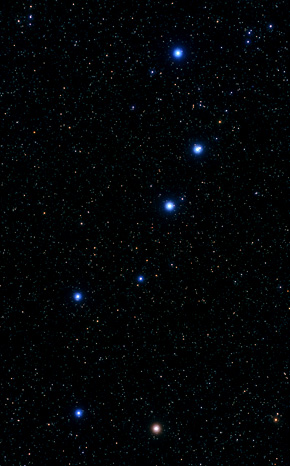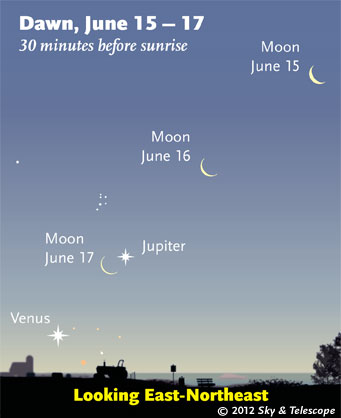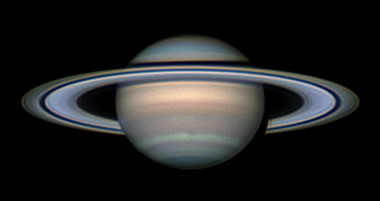
The Big Dipper hangs bowl down high in the northwest these evenings. Alcor here is buried in the glow of Mizar, the star at the bend in the handle.
Akira Fujii
Friday, June 8
Saturday, June 9
Sunday, June 10
Monday, June 11
Tuesday, June 12
Wednesday, June 13

Early risers can watch the waning Moon march toward Jupiter and Venus, which are emerging this week from the sunrise glow. (The visibility of the dim objects in bright dawn is exaggerated here. For clarity, the Moon is shown three times its actual apparent size.)
Sky & Telescope diagram
Thursday, June 14
Friday, June 15
Saturday, June 16
Want to become a better amateur astronomer? Learn your way around the constellations. They're the key to locating everything fainter and deeper to hunt with binoculars or a telescope.
For an easy-to-use constellation guide covering the whole evening sky, use the big monthly map in the center of each issue of Sky & Telescope, the essential magazine of astronomy. Or download our free Getting Started in Astronomy booklet (which only has bimonthly maps).
Sky Atlas 2000.0 (the color Deluxe Edition is shown here) plots 81,312 stars to magnitude 8.5. That includes most of the stars that you can see in a good finderscope, and typically one or two stars that will fall within a 50× telescope's field of view wherever you point. About 2,700 deep-sky objects to hunt are plotted among the stars.
Alan MacRobert
Once you get a telescope, to put it to good use you'll need a detailed, large-scale sky atlas (set of charts). The standards are the little Pocket Sky Atlas, which shows stars to magnitude 7.6; the larger and deeper Sky Atlas 2000.0 (stars to magnitude 8.5); and the even larger Uranometria 2000.0 (stars to magnitude 9.75). And read how to use sky charts effectively.
You'll also want a good deep-sky guidebook, such as Sue French's Deep-Sky Wonders collection (which includes its own charts), Sky Atlas 2000.0 Companion by Strong and Sinnott, the bigger Night Sky Observer's Guide by Kepple and Sanner, or the classic if dated Burnham's Celestial Handbook.
Can a computerized telescope replace charts? I don't think so — not for beginners, anyway, and especially not on mounts and tripods that are less than top-quality mechanically (able to point with better than 0.2° repeatability). As Terence Dickinson and Alan Dyer say in their invaluable Backyard Astronomer's Guide, "A full appreciation of the universe cannot come without developing the skills to find things in the sky and understanding how the sky works. This knowledge comes only by spending time under the stars with star maps in hand."
This Week's Planet Roundup
Mercury (about magnitude –0.8) is very low in the west-northwest about 30 or 40 minutes after sundown. Don't confuse it with Capella well to its upper right, in the northwest.
Venus, having crossed the Sun from east to west during its transit on June 5th, is now very deep in the brightest glow of dawn. Don't confuse Venus with Jupiter, which is less low in the dawn and somewhat to the right. The two planets are 14° apart on the morning of June 9th and 9° apart by June 16th. Use binoculars as daylight brightens; look just above the east-northeast horizon. Jupiter and Venus are on their way up for a grand showing high in the morning sky this summer.
Mars (magnitude +0.6) shines orange near the hind foot of Leo, in the southwest at dusk and lower in the west as evening grows late. Mars is still less than halfway from Regulus (off to its lower right) to the Saturn-and-Spica pair (left). Mars will shoot the gap between Saturn and Spica in mid-August.
In a telescope Mars is gibbous and tiny (about 7.3 arcseconds wide), continuing to fade and shrink.
Jupiter is coming into view deep in the glow of sunrise. See Venus above.

Saturn on June 11th. South is up. Imager Christopher Go writes, "The North North Temperate Zone (NNTZ) is very bright green" in this exaggerated-color image. "Note the bright white spot on the NNTZ" near the central meridian "and the dark barge right next to this white spot." The System III longitude of Saturn's central meridian was 181°; System II, 329°.
Saturn (magnitude +0.6, in Virgo) shines high in the south as twilight fades. Below it by 5° is Spica. Later after dark they move to the southwest. In a telescope, Saturn's rings are currently tilted 12.5° from edge on.
Uranus (magnitude 5.9, at the Pisces-Cetus border) is in the east before the first light of dawn.
Neptune (magnitude 7.9, in Aquarius) is in the southeast before dawn. Use our Finder charts for Uranus and Neptune.
All descriptions that relate to your horizon — including the words up, down, right, and left — are written for the world's mid-northern latitudes. Descriptions that also depend on longitude (mainly Moon positions) are for North America. Eastern Daylight Time (EDT) equals Universal Time (also known as UT, UTC, or GMT) minus 4 hours.
Like This Week's Sky at a Glance? Watch our weekly SkyWeek TV short. It's also playing on PBS!
To be sure to get the current Sky at a Glance, bookmark this URL:
http://SkyandTelescope.com/observing/ataglance?1=1
If pictures fail to load, refresh the page. If they still fail to load, change the 1 at the end of the URL to any other character and try again.
 0
0
Comments
You must be logged in to post a comment.